|
The Original Traveling Storage
Container
by Bob Brooke
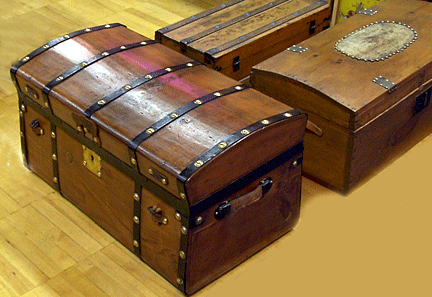 Steamer
trunks, which got their name from their storage location on a
steamer ship, first appeared in the late 1870s, although most date
from between 1880 and 1920. While some had flat tops, those with
rounded tops were for those who wanted to try to have their trunk
placed on the top of piles in the baggage compartments, so they
wouldn’t be damaged. When people traveled, they did so for a longer
periods because travel by train, and especially sailing ships or
coastal steamers, was slow. Steamer
trunks, which got their name from their storage location on a
steamer ship, first appeared in the late 1870s, although most date
from between 1880 and 1920. While some had flat tops, those with
rounded tops were for those who wanted to try to have their trunk
placed on the top of piles in the baggage compartments, so they
wouldn’t be damaged. When people traveled, they did so for a longer
periods because travel by train, and especially sailing ships or
coastal steamers, was slow.
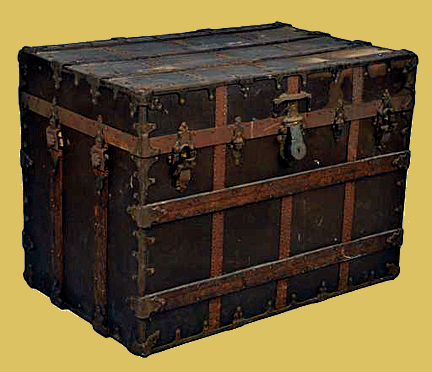 A
trunk, also known as a travel trunk, is a large cuboid container
designed to hold clothes and other personal belongings. They were
most commonly used for extended periods away from home, such as for
boarding school, or long trips abroad. Trunks were differentiated
from chests by their more rugged construction due to their intended
use as luggage, instead of the latter's pure storage. A
trunk, also known as a travel trunk, is a large cuboid container
designed to hold clothes and other personal belongings. They were
most commonly used for extended periods away from home, such as for
boarding school, or long trips abroad. Trunks were differentiated
from chests by their more rugged construction due to their intended
use as luggage, instead of the latter's pure storage.
There were many styles of trunks, including the Jenny Lind,
Saratoga, monitor, steamer or Cabin, barrel-staves, octagon or
bevel-top, wardrobe, dome-top, barrel-top, wall trunks, and even
full dresser trunks. These differing styles often only lasted for a
decade or two as well, and—along with their hardware—can be
extremely helpful in dating an unmarked trunk.
History and Construction
Although trunks have been around for thousands of years in China and
elsewhere, the most common styles seen and referred to today date
from the late 18th century to the early 20th century, when the
cheaper and lighter suitcase replace them.
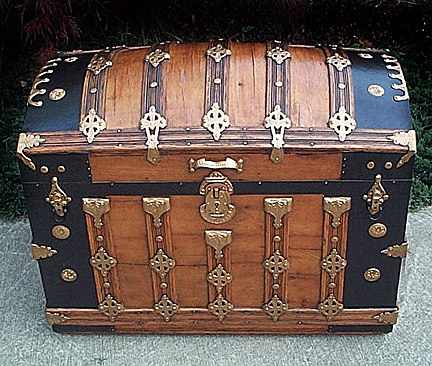
Trunks generally consisted of a base trunk box made of pine covered with
protective and decorative materials. Some of the earliest trunks sported
studded hide or leather and looked much like the furniture of the same
period since many furniture makers also produced trunks. Later coverings
included paper, canvas, plain or embossed tin, with an uncounted
assortment of hardwaree and hardwood slats to hold it down.
Famous Companies
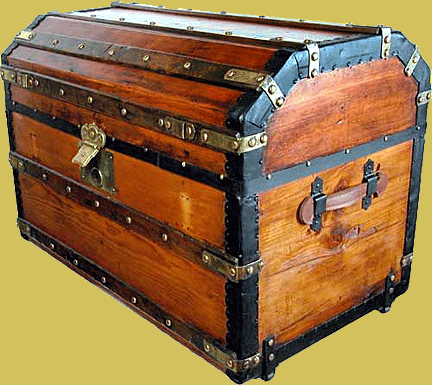 There
were hundreds of trunk manufacturers in the United States. A few of the
larger and well known companies included Rhino Trunk & Case, C.A.
Taylor, Haskell Brothers, Martin Maier, Romadka Bros., Goldsmith & Son,
Crouch & Fitzgerald, M. M. Secor, Winship, Hartmann, Belber, Oshkosh,
Seward, and Leatheroid. One of the largest American manufacturers of
trunks was Seward Trunk Company of Petersburg, Virginia. Shwayder Trunk
Company of Denver, Colorado later became Samsonite. Another was the
English luxury goods manufacturer H.J. Cave trading since 1839. Some of
the better known French trunk makers included Louis Vuitton, Goyard,
Moynat, and Au Départ. There
were hundreds of trunk manufacturers in the United States. A few of the
larger and well known companies included Rhino Trunk & Case, C.A.
Taylor, Haskell Brothers, Martin Maier, Romadka Bros., Goldsmith & Son,
Crouch & Fitzgerald, M. M. Secor, Winship, Hartmann, Belber, Oshkosh,
Seward, and Leatheroid. One of the largest American manufacturers of
trunks was Seward Trunk Company of Petersburg, Virginia. Shwayder Trunk
Company of Denver, Colorado later became Samsonite. Another was the
English luxury goods manufacturer H.J. Cave trading since 1839. Some of
the better known French trunk makers included Louis Vuitton, Goyard,
Moynat, and Au Départ.
Dating a Trunk
The easiest way for the casual observer to date any trunk is still by
examining its style, so a short description of each aforementioned major
variety follows.
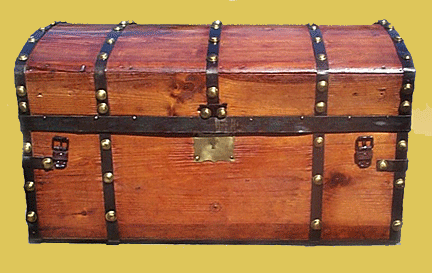
Jenny Lind trunks have a distinctive hour glass or keyhole shape when
viewed from the side. They were named after the Swedish singer of the
same name who toured America in 1850 - 1852 along with PT Barnum.
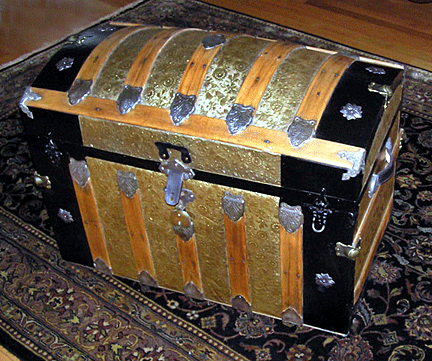 Saratoga
trunks were the premium trunks of many makers actually could encompass
nearly every other style of trunk manufactured before the 1880s. The
most readily recognizable feature of Saratogas were their myriad and
complex compartments, trays, and heavy duty hardware. Saratoga
trunks were the premium trunks of many makers actually could encompass
nearly every other style of trunk manufactured before the 1880s. The
most readily recognizable feature of Saratogas were their myriad and
complex compartments, trays, and heavy duty hardware.
Monitor-tops, incorrectly known as water-fall trunks from the furniture,
date from the late 1870s to the late 1910s. They had rounded front and
rear corners which formed a lying-down "D" when viewed from the side.
Earlier examples usually included labor-intensive hardwood slats while
there was a revival much later with rarer, all-metal ones being used.
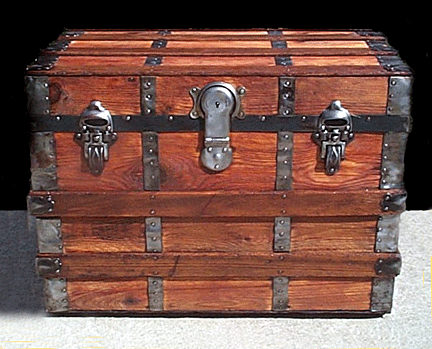 Steamer
trunks, sometimes referred to as flat-tops, first appeared in the late
1870s, although the greater bulk of them date from the 1880s to the
1920s. Their flat or slightly curved tops, usually covered in canvas,
leather or patterned paper, distinguished them from others. They stood
about 14 inches tall to accommodate steamship luggage regulations. Some
old catalogs referred to them as "packers," while a "steamer" trunk
actually referred to one often called a cabin trunk. Steamer
trunks, sometimes referred to as flat-tops, first appeared in the late
1870s, although the greater bulk of them date from the 1880s to the
1920s. Their flat or slightly curved tops, usually covered in canvas,
leather or patterned paper, distinguished them from others. They stood
about 14 inches tall to accommodate steamship luggage regulations. Some
old catalogs referred to them as "packers," while a "steamer" trunk
actually referred to one often called a cabin trunk.
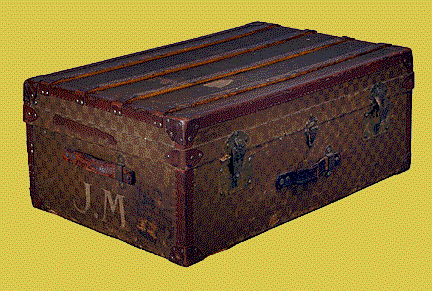 Cabin
trunks, sometimes called "true" steamer trunks, were the equivalent of
today's carry-on luggage. They were low-profiled and small enough to fit
under the berths of trains or in the cabin of a steamer, hence their
name. Manufacturers made them with flat tops and an inner tray
compartment to store the owner's valuables deemed too valuable to stow
in the baggage car or ship's hold. Cabin
trunks, sometimes called "true" steamer trunks, were the equivalent of
today's carry-on luggage. They were low-profiled and small enough to fit
under the berths of trains or in the cabin of a steamer, hence their
name. Manufacturers made them with flat tops and an inner tray
compartment to store the owner's valuables deemed too valuable to stow
in the baggage car or ship's hold.
Hat trunks were square shaped trunks that were popular in the 1860s to
the 1890s. Also known as "half-trunks," They were smaller and easier to
carry and could hold up to six hats or bonnets. Most had flat tops, but
some had elegant domed lids. Victorian women loved this trunk style,
thus antique trunk labels often refer to this type as a "ladies' trunk."
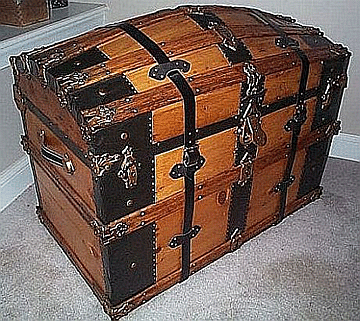 Barrel-staves,
made from the late 1870s to the mid-1880s and sometimes referred to as a
form of dome-top trunk, generally date from a decade or more earlier and
were notable for having horizontal slats instead of vertical, giving
them a distinctive look. Barrel-staves,
made from the late 1870s to the mid-1880s and sometimes referred to as a
form of dome-top trunk, generally date from a decade or more earlier and
were notable for having horizontal slats instead of vertical, giving
them a distinctive look.
Bevel-tops, separated into an early and a later revival period. The
early ones generally date from the 1870s to the 1880s while the later
ones date from 1890 to 1900. They had a distinct trapezoidal shape when
viewed from the side, although the earlier ones usually had a much
shorter flattened top section than the later ones.
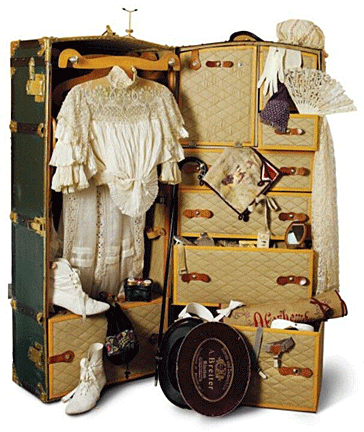 Wardrobe
trunks had to be stood on end to be opened and had drawers on one side
and hangers for clothes on the other. Many of the better wardrobe lines
also included buckles/tie-downs for shoes, removable
suitcases/briefcases, privacy curtains, mirrors, make-up boxes, and just
about anything else imaginable. These were normally very large and heavy
as they were used for extended travel by ship or train. Wardrobe
trunks had to be stood on end to be opened and had drawers on one side
and hangers for clothes on the other. Many of the better wardrobe lines
also included buckles/tie-downs for shoes, removable
suitcases/briefcases, privacy curtains, mirrors, make-up boxes, and just
about anything else imaginable. These were normally very large and heavy
as they were used for extended travel by ship or train.
A dome-top trunk had a high, curved top that could rise up to 25 to 30
inches. Makers employed a variety of construction methods, including
curving, molded ply, barrel construction, and so on, to form the inner
boxes. Included in this classification were camel-backs, which were
distinguished by having a central, vertically running top slat that is
higher than its fellows, hunch-backs or hump-backs which were the same
but had no slat in the center of the top, and barrel-tops, not to be
confused with barrel staves, which had high arching slats that were all
the same height. These trunks date from the 1870s to the 1900s.
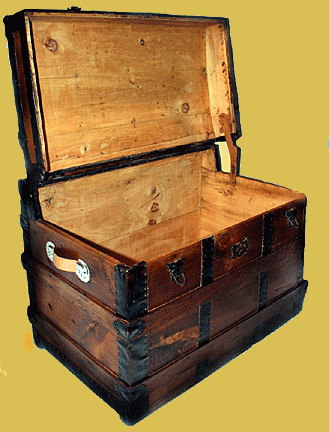 Manufacturers
produced wall trunks with special hinges so that when opened they could
stand flat up against a wall. Clinton and Miller both made them, and
each stamped their name on the hinges. Manufacturers
produced wall trunks with special hinges so that when opened they could
stand flat up against a wall. Clinton and Miller both made them, and
each stamped their name on the hinges.
Dresser trunks also known as pyramidal trunks, due to their shape, were
a unique form of wall-trunk that generally date from 1900 to 1910. They
featured a lid that opened up nearly the entire front half of the trunk,
allowing it to rest on the bottom. Two prominent manufacturers of wall
trunks were F. A. Stallman and Homer Young & Co.
Manufacturers built oak-slat trunks incorporating different tops, such
as the dome-top, flat-top, and beveled-top, built on a wooden frame,
where the malletier would fit thin oak slats vertically side-by-side,
covering the entire trunk. To a Victorian, this displayed not only the
complexity of the trunk and skill of the malletier, but also indicated
wealth to any purchaser. Several companies, including the Excelsior
Company, MM (Martin Maier) Company, Clinton Wall Trunk Manufactory, and
El Paso Slat Trunk Company, produced oak-slat trunks. Some made their
oak-slat trunks with alternating colors on the vertical slats.
<
Back to More Antique Spotlights
Next Article >
|
